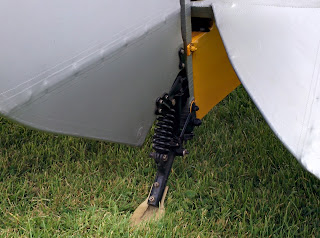There are three things to worry about when you're taxying. First off, the fin (the vertical surface on the tail). When you're taxying across the wind, the wind pushes it sideways, which "weathercocks" the aircraft into the wind. To avoid it, you need to steer out of the wind with the rudder. This is why the aircraft has almost no fin and a huge rudder: it's hinged so that almost the whole surface turns.
On the ground, the main steering is provided by a tail skid. It's attached to the bottom of the rudder so that it turns with the rudder: working the rudder pedals also turns the skid.
 |
| The tail skid on the bottom of the rudder. |
For this reason, you need to work the stick forwards and backwards. When you're taxying into wind, you need the stick all the way back. This raises the elevator, creating downward "lift" from the wind. But when the wind is behind you, it would hit the underside of the elevator, lifting the tail. So in this case, you need the stick all the way forward, keeping the elevator lowered (as it is in the top-right of the photo).
There's one last thing the wind does to you when taxying: it creates lift on the main wings, just like when you're flying. If the wind is from the front, you get lift on both wings. This is just what you need when taking off. But if it's from the side, the fuselage of the aircraft blocks the wind on the other side. This means the wing that's in the wind will get more lift, so it'll try to tip the aircraft on its side. To counter this, you need to try to roll the aircraft the other way. How you do this again depends on whether the wind is in front of or behind you. In front of you, you turn the stick into wind to try to roll that direction, just like when you're flying. But when it's behind you, and the airflow over the wing is backward, you need to pull the stick to the opposite side. As with the elevator, this stops the wind hitting the underside of the ailerons.
It seems like a lot to remember, but there's an easy way to think about it. This was originally taught to the RAF pilots who learned to fly Tiger Moths before going onto Hurricanes and Spitfires.
The wind is like a Messerschmitt. If it's in front of you, you attack by climbing and turning towards it. If it's behind you, you escape by diving and turning away from it.If you just remember this, you'll always know where to put the stick when it's windy, and you're less likely to scrape a wing tip on the ground, or worse yet, cut the grass with the propeller.
I expect Luftwaffe pilots learning to fly on the Bücker 131 were taught that the wind is a Hurricane, which makes a lot more sense as an analogy. A lot of training mnemonics from the War have survived today, especially in historical flying clubs like Cambridge Flying Group. Another favourite is, "Never fly straight for more than 30 seconds in the combat zone." In war, it's important to turn every so often in case an enemy is on your tail. Even in peace time, you should do the same clearing turns, about 30 degrees to one side and then back, to check the blind spots behind your wings and the nose cowling. Around Cambridge and nearby Duxford (home of an aviation museum), it's not entirely unlikely that your blind spot might be concealing a Bf-109.
No comments:
Post a Comment